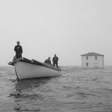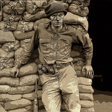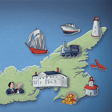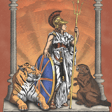Become a Creator today!Start creating today - Share your story with the world!
Start for free
00:00:00
00:00:01

Mi'kmaw Myths & Canadian Lore
Gather 'round the campfire with Mi'kmaw poet Julie Pellissier-Lush for spine-tingling tales of the supernatural. Reclusive river sprites, ice-hearted ogres, and a storm-summoning giant lynx stalk the wilderness in this storytelling session with additional guest author Amir Aziz and hosted by Canada's History magazine senior editor Kate Jaimet. Image illustration: Axana Zasorina
Transcript
Introduction and December 2023 Issue
00:00:05
Speaker
Welcome to Canada's History's Stories Behind the History podcast. I'm Kate Jamit, senior editor of Canada's History magazine. And in this podcast, we take a deeper look at some of the stories in our award-winning print publication.
Mi'kmaq Legends and Supernatural Stories
00:00:18
Speaker
In our December 2023 issue, Amir Aziz takes a dive into the supernatural with spooky stories of myths and monsters from across Canada. Amir is a writer based in Toronto whose work has also appeared in The Walrus and in Asparagus magazine. Amir, welcome to the podcast.
Story of the Maiden and the Magician
00:00:35
Speaker
Thank you so much for having me here, Kate.
00:00:38
Speaker
And I'd also like to welcome Julie Pelisier-Lush. Julie is a Mi'kmaq poet, author, actor, and storyteller. And she's here to share some Mi'kmaq legends with us today. Julie, welcome to the podcast. Thank you so much for having me. This is going to be fun. Yes, it is. And it is already, as we record this, heading toward winter. The leaves are changing here in Ottawa. Summer is waving goodbye. The nights are getting longer. Julie.
00:01:07
Speaker
This is the time for storytelling, right? It definitely is a time where we gather by the fire at night and entertain ourselves and pass on our history and culture through the use of storytelling. And you know a lot of Mingua stories, so why don't you just start us off with one, tell us a story.
Toronto Lighthouse Urban Legend
00:01:26
Speaker
All right. Well,
00:01:28
Speaker
We'll start with a story that is a little bit creepier than most, but I love it just as well. But this is a story of a beautiful young maiden who lived with her mother and father. And in that same village, there was a magician. Now, that is the current name for it, but he would have been a healer at some point in time, but he learned some of the darker arts and decided that, you know, he would learn a little bit more.
00:01:58
Speaker
And he fell in love with that beautiful young maiden and he went to court her. He went to go in and talk to her and try to woo her and get her to agree to marry him. But she did not want anything to do with them. She had heard the whispers and rumors that his healing talents are slowly turning dark and it scared her. So she dismissed him and went back into her lodge with her parents.
00:02:24
Speaker
Now, he was so angry. Everybody in the community had looked up to him. Everybody in the community had gone to him when he was in need, when they were in need. And he knew that he should have a position of somewhat of more authority and should be able to find the love that he wanted in his own community. So this made him really angry. So he decided to go out and use some of those dark arts that he had been looking for.
00:02:53
Speaker
And when he went out, he found this this horrendous plant that created horrible things to the Mi'kmaq people. So he collected it, gathered it, dried it and added it into a tea and he left it by her house. And so she went out thinking her mother and father had made her a tea. So she drank this tea down. And very soon her heart started to harden.
00:03:24
Speaker
She could feel her body going chill inside. And she knew that she was changing into something that wasn't human anymore. And of course, the magician, the one who was a past healer, watched in horror that what he was creating, because her hair started to fall out, her teeth started to fall out, chunks of skin started to fall off of her.
00:03:53
Speaker
And within this whole process, she was crying and her parents came back and held her. And they realized that they were gonna have to let her go before she transformed completely into this creature. And they didn't know how to fix it, but the magician at least had enough heart for her left to tell the parents that the only way that they could end this creature's life that she was becoming
00:04:23
Speaker
was to shoot seven arrows into her heart. And she begged her parents to do this, and they did. And then after, they had to take the heart out, and it was a big chunk of ice. And they had to put that heart into a fire that would go on for seven days, and then finally the heart would melt and disintegrate. And that was the only way she was released from that horrible,
00:04:54
Speaker
horrible curse that was changing her into what would later be called the chinu. Because the chinu soon evolved and transformed. Because of that very first curse, it started to spread. People heard about this plant and they started to cultivate it for when they had an anger or an issue with somebody. So there was more chinus that were created after.
Kayaking on Lake Superior and Supernatural Weather
00:05:23
Speaker
this whole story took place. Well, that is a wonderful story and very creepy. I would like to talk more about it and more about more Mi'kmaq stories, but maybe Amir, I wonder if you could chip in. When I asked you to write about this for Candace History, you were very enthusiastic and it turned out you told me that you have been fascinated with spooky, scary stories for quite a long time.
00:05:51
Speaker
Can you either tell us a story or tell us about why you're fascinated with them and what is it that holds these stories for you? I can do both, but let's do it in the reverse direction. So I do have a story for us today that did not make it into the article because it's not related to a being or a figure per se, but rather it's
Cultural Significance of Storytelling
00:06:14
Speaker
a grisly urban legend about a lighthouse in the Toronto area and why you might not want to hang around that lighthouse for too long.
00:06:22
Speaker
So Toronto, of course, it's on the shores of Lake Ontario, but that city is girded by about 15 little islands that kind of make a crescent shape around the city. You could say that the islands shield the city from the larger world, or maybe they shield the larger world from Toronto. You know, who knows? However you want to put it. The largest one of these islands is Centre Island, and it's a nice place to go.
00:06:43
Speaker
You've got rides and bike trails there's a clothing optional beach if you're into that sort of thing and there's also a lighthouse on the southern edge of the island that's a place called Gibraltar point and this lighthouse was constructed in eighteen oh nine to my knowledge and it's one of the oldest buildings in the city.
00:07:02
Speaker
Every lighthouse has a keeper, and this lighthouse's first keeper was a gentleman named John Paul Radlemüller. I believe how you pronounce it from the German. Radlemüller allegedly kept a stock of bootlegged beer on the premises, which he sold to Soldiers Garrison at Fort York. That's a military fortification on the mainland, about a five-minute ferry ride over. It's still there to this day. You can go see it if you like.
00:07:25
Speaker
So for years, soldiers at Fort York would row out to the island and meet up with Raul Mueller to purchase his beer. However, one night, a group of soldiers partying on the island with their with their bootleg beer accused Raul
Story of the Elderly Couple and Miraculous Boy
00:07:40
Speaker
Mueller of watering down his product. A drunken fight occurred and in the brawl, the soldiers accidentally killed him.
00:07:47
Speaker
So sobering up, they decided to hide their crime by chopping his body to pieces and scattering it around the lighthouse. They then rode back to the fort keeping that terrible secret in their hearts.
00:07:58
Speaker
Now, the second lighthouse keeper might have been the one to actually figure out that it had been an actual murder and that this first lighthouse keeper, Robert Mueller, had him just like up and left because, allegedly, according to the legend, the second lighthouse keeper arrives, he's new on the job, and as he's walking around his new lighthouse, he finds a piece of human jawbone.
00:08:22
Speaker
And that is why to this day, according to the legend, the other pieces of Ronald Mueller are still out there. And if you hang around too long, you might be the unfortunate person who finds another bitter. Amir, that is so gruesome and I love it. OK, before we talk about stories in general, I want to tell you something that happened to me. And this is a true story. It happened in Lake Superior.
00:08:52
Speaker
So there is a legend that in Lake Superior there is a great lynx, which I believe the Ojibwe call Mishipeshu, and that this great lynx monster lives in the depths of Lake Superior. And it can exert its influence even if you don't see it. So it's not necessarily that it's going to come up and attack you per se, but it's very powerful.
00:09:20
Speaker
And I think it's possible that I might have had an encounter with Michy Pashu. So I'll tell you this story. And this is a true story. I was doing a kayaking trip on Lake Superior, and it was on a string of islands that were offshore. So we had to actually take a motorboat for about half an hour offshore. So it's quite a ways to get out to these islands. And then we were paddling from one island to the other all along this string of islands.
00:09:50
Speaker
And when you're out on Lake Superior there where we were, there's not like a lot of boat traffic. There's not a lot of people around. So we were just completely on our own. And so at one point it was getting toward the late afternoon and we had finished paddling along one island. We had to cross over this open water about a kilometer of open water to get to the next island, which is where we were going to camp that night.
00:10:17
Speaker
So, we're doing pretty well, so we start paddling, we start paddling. And all of a sudden,
00:10:23
Speaker
there's this sound behind us coming up from behind where we're paddling toward. And it sounds like galloping horses, like, it sounds like this herd of horses galloping towards you. And the sky is kind of getting a bit darker. And I look around and all of a sudden this big rain squall just comes right over us, comes right over us and gallops off into the distance, just a rain squall out of nowhere.
00:10:51
Speaker
So that was kind of creepy, but you know, it's nature, rain squalls can happen. So we keep paddling along and then all of a sudden the water starts getting bigger. Like there was already waves, I mean it's like superior, but suddenly they're rolling and suddenly they're huge and suddenly you're on these big swells and your kayaks are going up and down and up.
00:11:14
Speaker
and down. And it's a little bit hairy and you're just making sure, okay, we don't want to tip or anything because Lake Superior is very cold and you can get hypothermia and we were not wearing wetsuits and it was still quite a distance to this other island. Now we're in between these two islands. So we're just managing this with these rolling swells and everything and just focusing on heading forward and then all of a sudden the fog.
00:11:38
Speaker
starts to roll in. And the island that's still about quite a fair distance away disappears. Can't see it. Can't see anything. The fog is closing in and we're trying to stay close together because you can barely see beyond the tip of your boat here. These are maybe 17-foot kayaks and there's just nothing. There's just nothing. You can't see anything. It's completely fogged in. So we cannot see where we're going.
00:12:07
Speaker
and Mike who I'm paddling with has a GPS.
00:12:11
Speaker
So he goes, well, don't worry. We've got this GPS. We just have to follow the GPS, and we're going to be fine. We're going to get there. And all of a sudden, OK, I'm not lying, this GPS starts malfunctioning. And the arrow that's pointing where we're supposed to go is like when first it's pointing straight ahead, then suddenly it starts pointing to the right, then suddenly it starts pointing to the left, then suddenly it starts pointing behind us. And we're just realizing we can't follow this GPS. It's going to just spin us in circles if we try to follow this.
00:12:40
Speaker
And we cannot see the island, and this is Lake Superior, right? And if you go out and you miss this island, you could be going. You could just keep on going, right? And this is where you start to hear that wreck of the Edmund Fitzgerald playing in your head, right?
00:12:59
Speaker
Mike was a really experienced paddler and he had been a field biologist with the Ministry of Natural Resources, very resourceful guy, tons of experience. So he pulls out a compass and he goes, okay, the GPS isn't working, but we can follow a compass line. And because he was a very experienced paddler, he had actually taken a compass reading before we left the previous island. So he knew the bearing that we needed to go to to get to this next island. So he
00:13:28
Speaker
He sets the compass line and we are literally blindly paddling through the fog on this compass line hoping that it is going to get us to this island because if it doesn't, we could literally
00:13:43
Speaker
going out into Lake Superior. And we paddled and paddled and it felt like an hour, but it probably wasn't that long. And then gradually out of this fog, you start seeing the outline of trees and of rocks and of shoreline and a huge sense of relief and gratitude when the kayaks pull up on this pevelled shore of this island. And Mike, we pull up the kayaks and Mike pulls out this pouch of tobacco.
00:14:12
Speaker
And he sprinkles it on the sprinkles tobacco on the water. And I say, Mike, what are you doing? What are you doing, Mike? And he says, we are thanking the spirit of Lake Superior that we got here safely. Yeah. And that was one of the most nerve wracking times of my life ever. So was it nature or was it Misha Peshew? I don't really know. I don't know.
00:14:41
Speaker
And I'm sure you were not in a hurry to get back on that kayak. Oh my gosh. We just wanted it to clear up, you know, like just make camp hope that the next day is clear. It was scary, but you know what? It made me think, and maybe we could talk about this, you know, where we're, so we're talking at the campfire later on and Mike says, you know, when you're out here,
00:15:05
Speaker
And the forces of nature are so great. And you really don't have technology. You don't have electric light. You don't have, you know, you're all on your own in these great forces of nature. You can see how beliefs and spirits and beliefs in creatures and beliefs in the supernatural really can just really seem so, so real to you at that time. And I wonder,
00:15:35
Speaker
It made me feel like this is maybe why we have these old, old legends. They come from that kind of a place. Julie, I don't know. What do you think about where these legends come from and the forces of nature, really?
00:15:51
Speaker
Oh my goodness, we are so connected. And I know I have so many stories that I have friends of mine who study our legends, who study our stories, and they find the kernel of truth that is being passed down from generation to generation, because that's how we connected who we were to who we are through our stories. They give us warnings. They give us our creation stories, how things all came to be.
00:16:20
Speaker
They gave us ways to believe in ourselves, even when things were desolate. And they gave us ways to save ourselves when we're on waterways that are usually quite familiar and safe. And those stories are passed down to protect us and to help us and to help us make sure that our generations will continue to thrive.
00:16:50
Speaker
Oh, my goodness. Well, I have one that isn't quite a creation story, but it's a why things are the way they are, which is sort of a creation story because that's how it comes to be. But it starts off with a little real story, which happened probably about 30 years ago over in Cape Breton. They found a wax cylinder and nobody really knew what to do with it. And it was in the
00:17:18
Speaker
It was in around the Indigenous community, so they gave it to them and they found a machine that could play said wax cylinder. And on that cylinder, they discovered that there was about 26 Mi'kmaq chants that had been recorded in the late 1800s.
00:17:36
Speaker
And they had to figure out the pace of which to play this machine, because if they play it too fast, you sound like Alvin and the chipmunks. And if you play it too slow, they sound really... It's not the same. So they had to figure out the tempo, and then they had to figure out some of the really old Big Ma that had been recorded on these wax cylinders.
00:18:00
Speaker
So one of the elders that had been working with it and translating, he found one of the songs and he literally fell in love with it. And he called it the Mi'kmaq love song, because when he heard it, he felt a rhythm in there that encompassed so much of who we were. And in his mind's eye, as he heard it, he envisioned a handsome brave
00:18:26
Speaker
gliding in a canoe and paddling and singing this song out into the universe looking for love. Because when a young man comes of age, they have to start, you know, deciding who they want to spend the rest of their life with. And so this song, the elder I talked to said,
00:18:44
Speaker
It reminded him of those traditions. So he thought in his mind's eye that as this song was playing, that it was an elder or young person singing and calling out for love and hoping that somebody on the shore would sing it back and they would start dating. And then after a year of courtship and proving that they would not die if they got married, because one had to hunt and one had to cook. And without those two skills, they would die.
00:19:13
Speaker
So they had to prove that they would be able to survive together, then they would be married, and they would sing the third verse. Now the song goes like this. Malia ta noua, el bitoa maega, el mi bidoe da. Malia ta noua,
00:19:43
Speaker
And then hopefully somebody on the shore, somebody nearby would sing that song back and they would start their courtship. Now that was a story that has a newer version, but in one of the older stories called the boy and the whale, it starts off with an older couple. They've never ever been blessed with children and that's okay. They had each other. They loved each other. They woke up to each other every day. They went to bed with each other every day.
00:20:12
Speaker
And they were so deeply in love and so connected that they lived their whole lives together without even missing having a child or children. So every season they would go around the different parts of PEI. They would go and collect walrus at one part and they would collect eel at one part and they would collect the berries.
00:20:34
Speaker
that they needed to have for the winter at another part. So they traveled all the way around here, there and everywhere together. But after many, many years, age started to catch up and the old man started to cripple up a little bit and the old woman started to lose her eyesight. And together they hobbled through the woods to keep going through their migration pattern.
00:20:59
Speaker
And they had to make a lot of sacrifice because a lot of times when they were hunting, the husband couldn't catch the food. And a lot of times the woman wouldn't be able to see how to cook it. And so the food would be destroyed. So between the two of them, they were hungry very, very often. But spring came to this beautiful land of Mi'kma'ki and it was time for them to go to the shore where they could dig clams. And as most people know, clams have a hard time running away.
00:21:29
Speaker
So the couple was guaranteed to have an amazing feed of clams. So they started digging and as they were digging, they could hear a noise. It sounded like a loud bang. And they looked up the shore and down the shore and there was nobody else on their shore. And they heard it again. But this time when they heard it, it was coming from under the ground. So they moved all the sand as fast as they could and there was a wooden box.
00:21:57
Speaker
buried under the ground. So they pulled the box up and they opened up the box and inside the box was a beautiful, healthy, giggling, smiling little baby boy. Wow, a baby they both thought. And they thought neither one of them would be able to take care of a baby. They were far too old and they weren't able to go and hunt and fish and provide for this baby.
00:22:27
Speaker
knowing that there was nobody else there. They knew it was their prerogative to go and look after this baby. So they committed to that baby. They said they would sacrifice even more to make sure that that boy got to grow up to be the man that the creator intended him to be. But the creator, I think, heard this commitment they made and sprinkled a little magic onto the story. And that baby started to grow. And within a week,
00:22:56
Speaker
That young baby looked like he was 15 years old. He could hunt, he could fish, and he could trap, and he could bring food to his mother and father. And they loved each other so dearly. Now one day, the boy came running into the lodge and said, mother, father, I have caught a whale. And they raced down to the shore with him.
00:23:20
Speaker
but they could only see a great big pile of oysters. So they took out their bone knife and started to crack them open. Now mother, as she was eating them, felt really funny in her stomach. So it made her giggle and she caught up and she started to dance around this huge pile of oysters. And soon enough, they looked at the shore and one of those oysters started to grow and grow.
00:23:46
Speaker
and grow and pretty soon he was the size of a whale. Now mother and father knew that they would have enough food for the whole winter long and that made them so happy. And of course, the son was getting to that age where it was time for him to start looking for love and knowing that his mother and father would be looked after, he started off on his own adventure, promising to return as soon as he can.
00:24:14
Speaker
So off they went and they made their winter camp. And very soon, sadly, the mother in the middle of winter passed away in her sleep, which left father all alone for the very first time and forever devastated him.
Exploring Human Nature and Cultural Preservation
00:24:29
Speaker
But he knew the protocols. So he wrapped her body in beaver pelts and tied it with leather string and then wrapped it again in birch bark. Now the ground was too hard for him to bury his beautiful wife
00:24:43
Speaker
So he found a cave and slid her body in and covered the mouth of the cave with the rock so nothing would disturb her throughout the winter. And he continued on his migration pattern all by himself.
00:24:57
Speaker
And within a twinkle of an eye, it was time for him to get back to his winter lodge. So he raced to the cave. He moved the rock. He pulled her body out. And in the story, it says he undid the leather wraps. He undid the beaver pelts. And he pulled them away to look with a big smile at the beautiful face that he had missed all winter long. And then he buried her after singing this song.
00:25:44
Speaker
And I'm sure in the spirit world, she answered him,
00:26:09
Speaker
Now the elders have told me that this story is one of the deeper stories because here in Mi'kma'ki we were here with our Akkadian partners, our allies,
00:26:21
Speaker
And we created a story that would represent the sacrifices that the Mi'kmaq people made to create an ally with the Acadians. Because the Acadians were just like that little baby when they first came here to Mi'kma'ki. They didn't know how hard the winters would be. They didn't know what foods were safe to eat. And we looked after them like we would a small child. We took care of them. And in return, they grew.
00:26:49
Speaker
and got stronger very, very fast and they helped us. And we created a partnership that lasts even to this day. Julie, I could sit here and listen to you for...
00:27:04
Speaker
hours. That was beautiful. That was really beautiful. It's really beautiful. I love the way your stories connect, you know, your history and your people's history and to Canadian history and to other people's history. It's beautiful.
Toronto Tunnel Monster and Urban Legends
00:27:22
Speaker
Amir, when you look into stories, for Julie, it's, you know, connecting to history. For you, what is the, what for you is the fascination of these stories and tales?
00:27:33
Speaker
Well, I think Julie already said it best, but I'll try to repeat what she said in my own words, if that's okay. I feel like stories are the original human technology, aren't they?
00:27:49
Speaker
They are the tools that we use and they have an infinite set of uses in the relation to our own being human. That also makes them complicated to talk about because unlike a hammer, screwdriver, or iPhone, a story is never just one thing, right?
00:28:05
Speaker
a scary story or any story at all like it can be used to enforce a community norm. One of the reasons that I love the tenu story so much is it Julie correct me if I'm wrong but to me I feel like that explores the horror not just of a
00:28:21
Speaker
of this monster that can come and eat you, but about what the human being is capable of when they are keep everything up here, but they miss the real human element, which is which is what we keep over here, isn't it? And there's more and there's more beyond that, right? Like there's also I think I referenced stories like the Rugaru and the Shaskari that's in the article.
00:28:51
Speaker
which can you can kind of view those stories as an attempt to bring two communities together and to say through our stories, we are one people now. And what interests me about scary stories, because I think that this is where it pops up the most, is that they try to explain or make sense of or reconcile the unknown, because I believe that's something that we don't understand as a species is somehow more scary to us than an actual existential threat.
00:29:19
Speaker
I love it because I love these stories and I love listening to you, Julie, because I spend my life immersed in journalism, right? Which is fact, fact checking, fact checking, fact checking, has to be logical, has to make sense, you know? But these stories don't, right? Like all of a sudden there's a sound and you dig up the sand and there's a baby buried in a box. Like there's this miraculous stuff that happens, right? And I think
00:29:48
Speaker
For me, especially with the world becoming so technologically advanced, sometimes I feel like I wish I could, especially when I'm going canoe camping, this is something for me, I wish I could strip away all the technology, all the built environment, all the gadgets and the electronics and everything. And just isn't there something essential that's there in nature? And I have that feeling myself. And then when I hear these stories, I feel like,
00:30:17
Speaker
They're talking about something primordial, right? Like something essential in nature that's there and that we don't know, right? That is still unknown to us. For me, that's a big attraction. And if I could interject, Kate, one could also argue that when you're pondering that, you're pondering the difference between fact and reality.
00:30:44
Speaker
It's true. You know, okay. And I love the story of the Toronto tunnel monsters and maybe I'm going to get you to tell that story. I'm here for people who haven't read the, um, your article because I love this story. And partly it's because of that, this feeling of what could be going on beneath the surface in both a metaphorical and a physical way. Can you tell us the Toronto tunnel monster story? I love this story. I absolutely can.
00:31:11
Speaker
So again, if you spend any time in the city, you'll know we're very proud of our ravine system. It's one of the one of the nice parts about about living here. So we have a ton of ravines, we have a bunch of rivers, we have a bunch of creeks. And as the city of York, which was, you know, was originally here before Toronto, as it became the city of Toronto, we have to divert a lot of those waterways into
00:31:40
Speaker
to drain into the lake so that people's houses wouldn't get flooded. They still get flooded, by the way, because when you dig up a river and dry it up, the river is still there. It just doesn't have water in it, as people find out in their basements every year when it gets especially rainy. Regardless, when the city began its reclamation from the waterways,
00:32:05
Speaker
it built these elaborate tunnel systems. If you see pictures of them, they're actually quite beautiful because they were built back in the days when everything had to be beautiful. It wasn't like bare walls or anything. We're talking vaulted ceilings, aesthetically pleasing arches and everything in these large tunnel systems, these large sewer systems. These are still part of the city's water treatment system to this day, if I remember correctly.
00:32:30
Speaker
That's just to set the story and to say that we have a bunch of aside from our modern sewage system, which is just a bunch of boring concrete tubes running underneath us. We also have some far more interesting, far more old pathways that are cut underneath us that might be just host to something.
Reclaiming Indigenous Identity Through Stories
00:32:51
Speaker
Who knows something? So this is a story from 1979, a 51-year-old man, his name was Ernest. He was looking for a missing kitten.
00:33:01
Speaker
Of course, he's looking around his apartment, which I believe is around Parliament Street or was a cabbage town or somewhere. And as he's crawling down, he eventually goes down a fire escape just thinking like, if I were a kitten, where would I go? And he happens to come across an entrance into one of these narrow passageways that leads into the antique tunnels.
00:33:23
Speaker
As he crept through the tunnel, he saw something that was not a kitten. Instead, this was a creature. It stood about a meter tall, so kind of short for a human, with long skinny limbs, and it was covered with gray fur, and it glared at him with these big red eyes.
00:33:42
Speaker
Now, apparently, this creature had some language ability, because apparently it hissed at him. Go away! And then it bolted down the tunnel, far away from Ernest. So Ernest, smart man, decides, yeah, that's good advice. I'm going out of here. And he left that tunnel as fast as he could.
00:34:00
Speaker
Can't blame him, good move. So since this sighting, the city has never again seen this creature, at least not by anyone willing to tell the story or maybe not by anyone who remains, who's seen it. But what I find really interesting is that some tunnel monster enthusiasts have suggested that given the buried streams flowing within the city, this sewer dwelling sprite,
00:34:29
Speaker
might be an urbanized version of the Memiguesi, which is, I believe, a small, hairy river spirit found in Ojibwa folklore. So perhaps when the city was re-diverting all of these rivers, there were some residents there at the time that just decided, hey, I don't care. I'm going to keep on living here.
00:34:51
Speaker
Yeah, it's fascinating this idea of layers upon layers upon layers, you know, layers of history, layers of architecture, layers of supernatural, the mimic we see could still be there.
00:35:07
Speaker
It makes me think a lot about all the attempts of the Jesuits and all these priests and everything coming over to Canada and bringing their religion, but I don't think that the original religions and the original spirits and what is there is there, right? It's not going to go away. Human time and human power is in no way a match for any of these big
00:35:32
Speaker
things, right? Either the geography or the power of nature or the spirits that may inhabit. And on that note, Julie, maybe can you share a bit for us about something you've learned in your looking into stories? Because you mentioned before we started recording the podcast, you mentioned that you don't speak Ming Ma because your grandfather went to residential school and
00:35:59
Speaker
as we know in the residential schools, the children were not allowed to speak their language and they were taken away from their parents and their culture. So Julie, maybe can you tell us a little bit about how you got into learning the Mi'kmaq stories and what they mean for you in terms of reclaiming your own culture and language?
00:36:19
Speaker
When you have a culture that has been through as much trauma as our indigenous culture all over Turtle Island, it is hard to find a pride in who you are. And these days now I see the tides changing. I see people who are stepping up and being role models that our young people can look up to.
00:36:45
Speaker
I see our stories being told again by our elders, and I know that it is a way for us to reconnect to who we are in the traditional form, in the traditional way of learning about Glooscap and the Creator and how we all came to be. All of that is, in essence, a way for us to find out, as Chief Justice Mary Sinclair always says, every child, every person,
00:37:14
Speaker
deserves to know who they are and where they come from. And sharing stories, sharing that knowledge, sharing those teachings helps to bring a sense
00:37:27
Speaker
pride and you know being able to show our children who they are is so important and using stories is such a gentle way to be able to do it because they don't need to take every single part of the story. They can take the part that resonates in their heart and they can use it and be able to get stronger and then each and every time they listen to it they'll learn a little more and that's the benefit and the bonus of stories is that
00:37:51
Speaker
It's just exactly what we need to be able to move forward together in reconciliation.
Conclusion and Subscription Invitation
00:37:59
Speaker
Thank you, Julie, for those thoughts. We're going to end on that. Thank you so much, both of you, for coming, for sharing your stories, for writing the article, and hopefully we'll talk again on a future podcast. Yes, thank you. I'd like that. Thank you both. Bye.
00:38:20
Speaker
The Stories Behind the History podcast is produced by Canada's History Society. If you enjoyed this podcast, why not subscribe to Canada's History magazine? To subscribe, or simply to find out more about Canada's History Society, visit us at canadathistory.ca. Our theme music is the Red River Jig, performed by Alex Custerock from his album, Métis Fiddling for Dancing. I'm Kate Jaymet, thanks for joining me.












